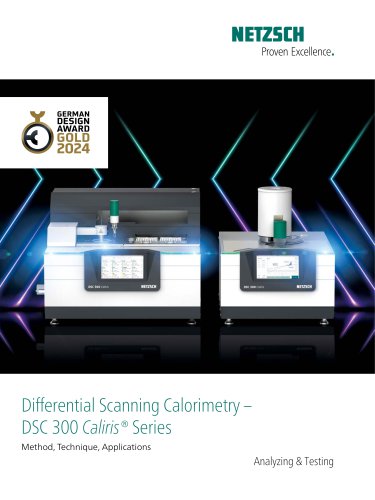 Website:
NETZSCH Analyzing & Testing
Website:
NETZSCH Analyzing & Testing
Group: NETZSCH
Catalog excerpts

Photo-DSC 204 F1 Phoenix® Photocalorimetry – Method, Technique and Applications Analyzing & Testing
Open the catalog to page 1
Photo-DSC 204 F1 Phoenix® Photo-Calorimetry Is an Extension of Classical Calorimetry for the Investigation of Light-Induced Processes. Your Benefits Light- (mostly UV-) curing systems react very quickly (within a few seconds at low isothermal temperatures) and are solvent-free. This makes them very attractive for industrial applications. Three different types exist: radical, cationic and dual-cure systems. Dual-cure systems exhibit a combiation of thermal and light-curing reactions and can be found, for example, in adhesives or paints. The ability to measure the curing kinetics and degree...
Open the catalog to page 2
Various Commercial Lamps Can Be Used for Optimum Curing The Photo-DSC 204 F1 Phoenix® can be equipped with mercury (Hg) lamps, diode laser systems or high-power LED lamps in order to achieve optimum curing results. Defined Light Source Distance for Reproducible Measurements Adjustable light guides provide for a constant distance between the light source and the sample and reference, respectively. Only reproducible measurement conditions ensure precise results. The light guides are mounted on the automatic cover lift for easy handling. Flexibility and Efficiency Across a Broad Temperature...
Open the catalog to page 3
TRENDSETTING TECHNOLOGY Photo-DSC Operation Differential scanning calorimetry (DSC) is a thermoanalytical method in which the difference between heat flow into a sample and into a reference, when subjected to a controlled temperature program, is quantitatively determined (definition based on DIN 51 007, ISO 11357-1 or ASTM E472). In photo-DSC measurements, both the sample and reference are located in one furnace and are irradiated simultaneously. The fiber optics are firmly installed in the lid to ensure reproducible distances between the fiber optics and the sample and reference. The DSC...
Open the catalog to page 4
UV Light Sources – You Have the Choice Software Features Recommended are mercury lamps such as OmniCure® S 2000 which allow for the selection of wide and narrow ranges; these should have filters in the UV-A range between 280 nm and 315 nm and in the UV-B range between 315 nm and 500 nm. However, other commercially available lamps can also be adapted. For optimized curing, a defined wavelength (e.g., 447 nm) can be used with diode laser systems or high-power LED (e.g., 365 nm, 400 nm or 460 nm) – depending on the resin to be cured. The OmniCure® lamp is fully software controlled; selection...
Open the catalog to page 5
Paints/Coatings Adhesives/Inks Dental Composites Pharma/Cosmetics Food/Chemicals second irradiation first irradiation Photo-DSC Measurement and Evaluation The sample and reference are irradiated with UV light at a constant temperature until the sample is cured. Afterward, the cured sample and the reference are irradiated for a second time for the same duration and at the same temperature. Finally, the difference between the first and second irradiation is calculated to determine the pure heat of reaction (curve subtraction). nitrogen:oxygen = 50%:50% DSC difference curve nitrogen 100%
Open the catalog to page 6
Paints under Different Atmospheres The irradiation for 1s of a sample of hexanediol diacrylate (HDDA) was investigated using three different atmospheres. The heat of crosslinking was at its highest under an inert atmosphere of 100% nitrogen (green curve) with 378 J/g. A mixture of 50% nitrogen and 50% oxygen yielded 268 J/g (blue curve); a pure oxygen atmosphere, only 170 J/g (red curve). There is obviously a competitive reaction due to the influence of oxygen. Adhesives at Different Temperatures This fluorescent one-component modified epoxy resin is activated with visible light of 400 nm...
Open the catalog to page 7
The NETZSCH Group is an owner-managed, international technology company with headquarters in Germany. The Business Units Analyzing & Testing, Grinding & Dispersing and Pumps & Systems represent customized solutions at the highest level. More than 3,800 employees in 36 countries and a worldwide sales and service network ensure customer proximity and competent service. Our performance standards are high. We promise our customers Proven Excellence – exceptional performance in everything we do, proven time and again since 1873. NGB · Photo-DSC 204 F1 Phoenix® · EN · 0221 · NWS · Technical...
Open the catalog to page 8All NETZSCH Analyzing & Testing catalogs and technical brochures
-
TG 309 Libra Series
24 Pages
-
STA 449 F5 Jupiter®
16 Pages
-
DMA 303 Eplexor
24 Pages
-
ARC® 244 ARC® 254
1 Pages
-
HMOR 422
1 Pages
-
RUL/CIC 421
1 Pages
-
Product Overview
12 Pages
-
Kinexus Prime DSR Series
20 Pages
-
DIL 402 Expedis Select/Supreme
28 Pages
-
Rosand Series
20 Pages
-
Kinexus Prime Series
20 Pages
-
Advanced Materials Testing
32 Pages
-
NTA Fire Testing Systems
20 Pages
-
NTA Guarded Hot Plate Series
16 Pages
-
Cone Calorimeter TCC 918
12 Pages
-
TMA 402 F1/F3 Hyperion®
16 Pages
-
NTA HotBoxes Test Chambers
16 Pages
-
Thermal Insulation Materials
24 Pages
-
TA-QMS Coupling
16 Pages
-
STA 2500 Regulus
12 Pages
-
SBA 458 Nemesis®
24 Pages
-
NTA HotBoxes
16 Pages
-
NETZSCH NEVIO Instrument Series
24 Pages
-
LFA 467 HyperFlash® Series
28 Pages
-
LFA 427 - product brochure
24 Pages
-
Kinetics NEO
16 Pages
-
TG-FTIR - product brochure
24 Pages
-
DMA GABO EPLEXOR up to 1500°C
12 Pages
-
DMA GABO DiPLEXOR
8 Pages
-
DIL 402 Expedis Classic
16 Pages
-
DEA 288 Ionic
20 Pages
-
Accelerating Rate Calorimetry
20 Pages
-
GABO DiPLEXOR®
8 Pages
-
GABOMETER®
8 Pages









































































